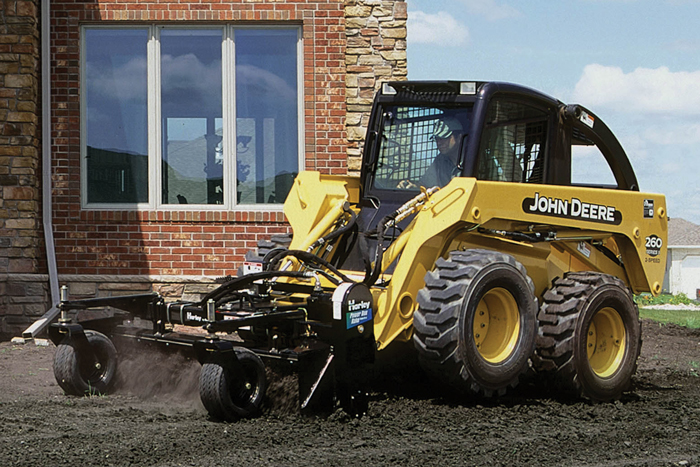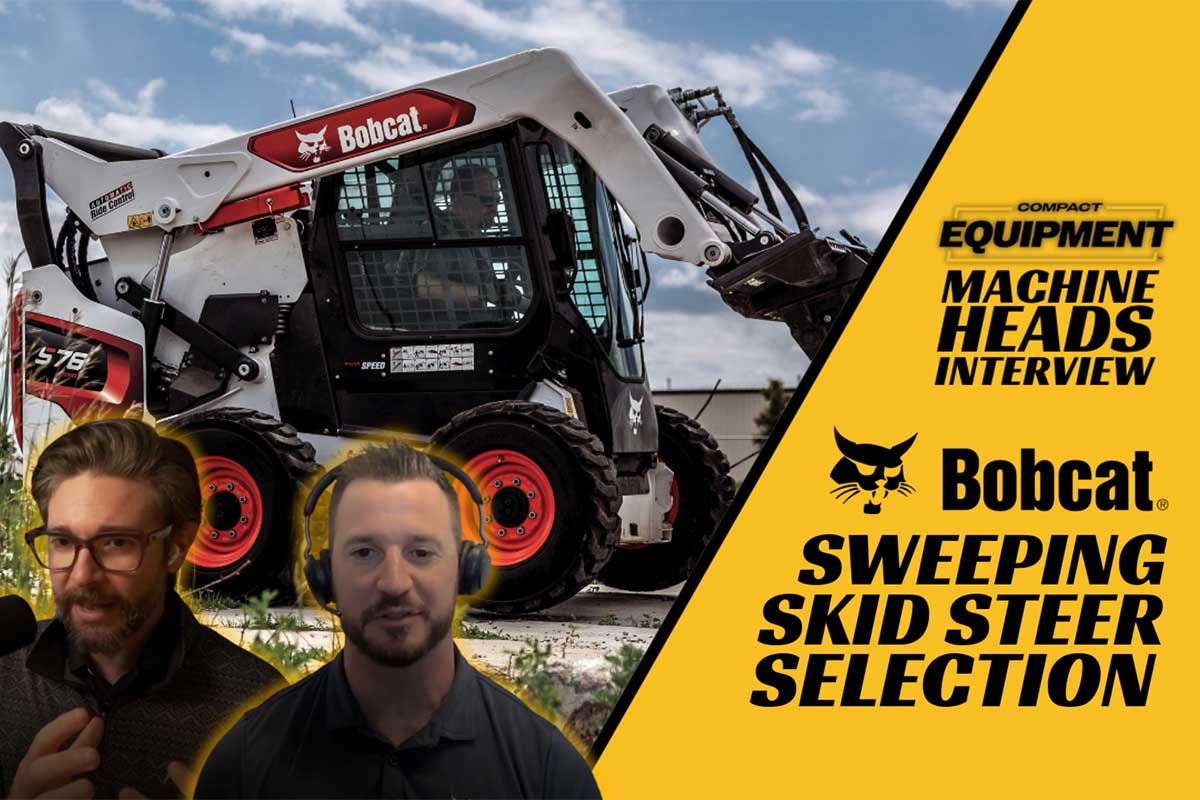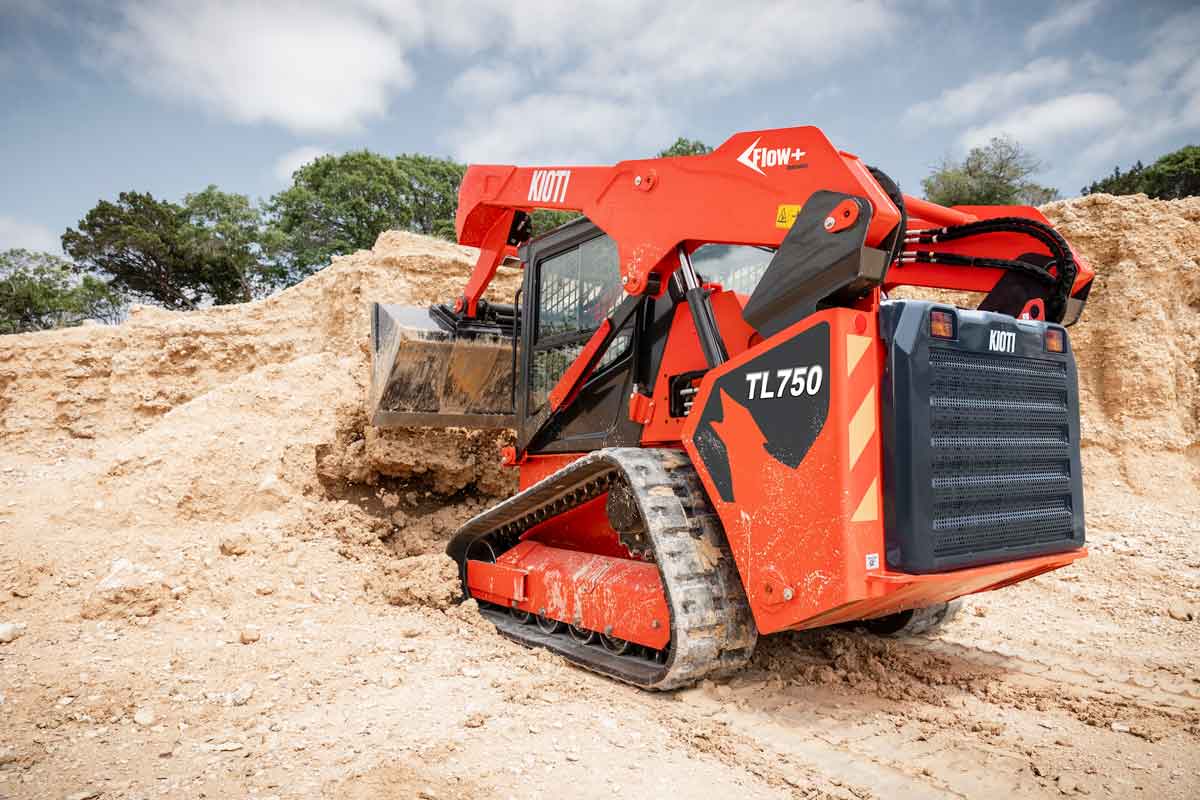A Box Blade with an Attitude
 The power box rake attachment is a versatile landscape tool that grew out of the traditional box blade or box grader that is typically mounted on the three-point hitch of a mid-sized tractor. The blade edge of these units is fixed, or static, and grades the material in front of the blade, similar to a bulldozer blade. However, the “blade edge” on a power box rake is actually live, or active, using a rotating steel tube — called a roller — with many carbide teeth aligned in multiple rows across its surface to move the material.
The power box rake attachment is a versatile landscape tool that grew out of the traditional box blade or box grader that is typically mounted on the three-point hitch of a mid-sized tractor. The blade edge of these units is fixed, or static, and grades the material in front of the blade, similar to a bulldozer blade. However, the “blade edge” on a power box rake is actually live, or active, using a rotating steel tube — called a roller — with many carbide teeth aligned in multiple rows across its surface to move the material.
“The secret weapon of the power box rake is that the carbide-toothed roller is spinning just below the surface of the working grade,” states Stephen Kingsley, market manager for Paladin Attachments. “The spinning roller pulverizes, lifts and gathers everything in its path. Objects like rocks or sticks that are too large to fit between the roller and the adjustable barrier are forced either to the side in a windrow or carried along to the grading end as hedge-rowed excess material — often referred to as overburden. The power box rake requires much less tractive effort from the carrier, as the spinning roller is moving the overburden out in front of the roller itself. Less tractive effort from the carrier translates to less wear and tear on the machine and less fuel consumption.”
A traditional box blade merely scrapes or drags the material, bringing the good materials along with the bad. The power box rake lifts and forces a wave of overburden to be raked through the carbide teeth on the powered roller and up against the resistance of an adjustable mold board, called a barrier. The attachment also employs box ends to carry, control and direct the overburden as desired for the specific application. In some cases, these box ends are fixed to protect hydraulic motor drives or adjustable and positional to add flexibility to the rake. The powered roller is what gives the power box rake its name.

Power box rake attachments are compatible with skid steer loaders or tractor three-point hitch applications. They are extremely versatile and can be used to pulverize topsoil, remove debris, finish grade, spread fill and topsoil, recondition hard soils, change grade, thatch turf areas and mix and homogenize top soils. Once the power box rake has been properly set up and adjusted, even a less experienced operator can successfully produce a model site prep and seedbed. Unlike other vegetation removal methods that tend to remove much of the workable top soil along with the vegetation, the power box rake will use the spinning carbide teeth to loosen most of the soil that is captured in the roots of the vegetation. Power box rakes are very effective at removing vegetation from turf areas. Many contractors even find the power box rake useful for drying out muddy jobsites and rejuvenating old turf.
The power box rakes are most often used in the light construction field by contractors involved in finish grading, site preparation, erosion control, sports turf and turf construction. They recognize that the inherent value of a power box rake allows them to easily replace three or four workers on the ground with hand rakes. Contractors in the residential asphalt construction field find that the power box rake is invaluable for sloping or level-grading driveways and bike trail paths. They use the attachment to knock down the high areas, fill in the low spots and pulverize the materials to the size of particle that they choose for proper compaction.
Proper Selection Is Key
Every attachment purchase requires careful investigation and feature comparisons. Foremost among these is the need to carefully match the attachment to the carrier. Just because a carrier may physically attach to the power box rake does not mean that they are truly compatible. The attachment horsepower, hydraulic flow and weight requirements must be within safe carrier operating specifications. A thorough investigation of the capabilities of your carrier must be made to assure the safe operation of your attachment. It is always helpful to work with your equipment dealer or manufacturer to determine proper fit.
Three basic questions must be answered for every attachment:
1. Can the attachment properly attach to the carrier?
2. Does the horsepower or hydraulic flow requirements of the attachment fall within the safe operating range of the carrier?
3. Does the operating weight of the attachment fall within the manufacturer’s recommended operational guidelines for the carrier?
Once the proper sized power box rake attachment is selected for the specific carrier, the next decision is the drive method. The roller can be driven in one of three different ways: direct motor hydraulic drive, hydraulic motor to chain reduction drive or PTO-to-clutch drive. Selecting the right power box rake for your application will depend on your choice of carrier and your preferred drive method. Have a discussion with your equipment dealer, your industry associates and your team to pin down your favorite for the operation at hand.
Tractor rear-mounted applications usually utilize a PTO drive through a shaft and clutch system that provides good mechanical transfer of power with little power loss. Rear tractor-mounted applications are generally easier to operate, but have diminished flexibility in shaping, creative grading and digging versus a front-mounted unit. In addition, PTO drive units are very unforgiving in the event of a severe shock load to the drive line caused by hitting a large object or engaging the drive at full speed.
Skid steer loader front-mounted applications utilize a hydraulic motor system driven via the auxiliary hydraulic flow of the carrier. There is some slight loss of mechanical efficiency in a hydraulic system, but the hydraulic drive will be more forgiving when faced with a severe shock load to the system. The traditional method utilizes a hydraulic motor through a heavy-duty chain reduction to power the roller. Another popular drive method utilizes a direct hydraulic motor drive, with the shaft of the motor or motors connected directly to the roller itself.
Know Your Attachment
All attachments have unique operating characteristics and require a careful and thorough read of the operator’s manual prior to safe operation of the attachment. With power box rakes, it is even more important to read these operations tips as many operators will not be familiar with the attachment. Choose a manufacturer that pays careful attention to safe operation of their attachment. The manual should not only cover proper setup and adjustment of the machine, but also operational procedures for safe use of the power box rake. Most will have detailed application techniques that will help get maximum efficiency from your new power box rake. As an example, finish grading will require different application angles and attitudes of the attachment than pulverizing topsoil will. In the case of the power box rake — reading is believing.
Mike McSorley is a product support and training representative for Paladin Attachments, which includes the Harley and FFC Attachments brands, based in Dexter, Mich.




